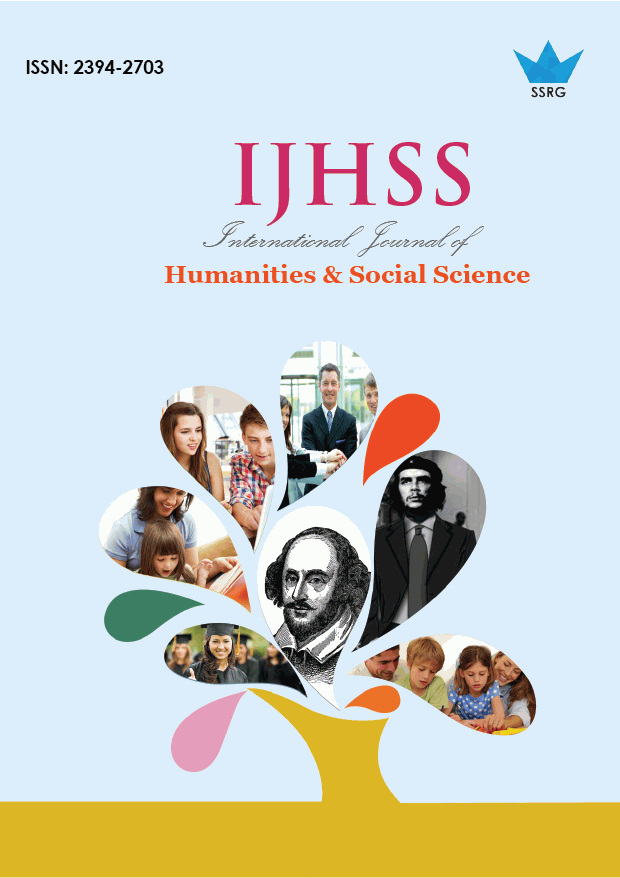Mapping Cultural Identity and Cultural Integration Among Two Generations of Immigrants in Singapore - Indian and Chinese

| International Journal of Humanities and Social Science |
| © 2025 by SSRG - IJHSS Journal |
| Volume 12 Issue 2 |
| Year of Publication : 2025 |
| Authors : Atiksh Sinha |
How to Cite?
Atiksh Sinha, "Mapping Cultural Identity and Cultural Integration Among Two Generations of Immigrants in Singapore - Indian and Chinese," SSRG International Journal of Humanities and Social Science, vol. 12, no. 2, pp. 38-51, 2025. Crossref, https://doi.org/10.14445/23942703/IJHSS-V12I2P105
Abstract:
Singapore is a highly cosmopolitan country that hosts people from various nationalities. Despite an environment presumed to be very cohesive and with different ethnic groups coexisting, cultural Integration varies among groups. This research sought to understand these differences and their underlying causes. A mixed methods study was conducted wherein 86 respondents were surveyed on cultural Integration and perceived cultural distance. In comparison, eight Indian and Chinese respondents were interviewed-four first-generation and four second-generation. Findings revealed that generational status did not affect perceived cultural distance or multicultural identity integration; however, ethnic background influenced how immigrants across generations perceived their cultural distance. No such findings were found for multicultural identity integration. Moreover, it was reported that individuals who feel a greater distance from the mainstream culture will make more significant efforts to mitigate that distance through Integration. Qualitative findings reveal that Indian immigrants experience greater lengths of subtle racism around Singapore, while Chinese immigrants deal with the troubles of adapting to the way of life in Singapore. All second-generation Respondents expressed stereotypical behavior positively and negatively across both groups. These findings underscore the significant role of ethnic background in shaping the acculturation process of Indian and Chinese immigrants within Singapore's multicultural landscape.
Keywords:
Cultural identity, Cultural Integration, Singapore immigration, Indian, Chinese.
References:
[1] Acculturation – iResearchNet, Administrator, Psychology, 2016. [Online]. Available: https://psychology.iresearchnet.com/counseling psychology/multicultural-counseling/acculturation/
[2] Doubly Minoritised: Indianness in Singapore and Xenophobia as Racism, Academia, 2022. [Online]. Available: https://www.academia.sg/academic-views/indianness-in-singapore/
[3] Stephanie Barros, and Isabelle Albert, ““I Feel More Luxembourgish, But Portuguese Too” Cultural Identities in a Multicultural Society,” Integrative Psychological and Behavioral Science, vol. 54, pp. 72-103, 2019.
[CrossRef] [Google Scholar] [Publisher Link]
[4] Nagendra Bahadur Bhandari, “The Cultural Negotiation: A Shift of Paradigm between First and Second Generation Immigrants in Lahiri’s The Namesake,” Prithvi Academic Journal, vol. 1, no. 1, pp. 88-98, 2018.
[CrossRef] [Google Scholar] [Publisher Link]
[5] Nagendra Bahadur Bhandari, “Family Dynamics: An Intergenerational Study on Asian American Narratives,” SCHOLARS Journal of Arts & Humanities, vol. 1, pp. 50-66, 2019.
[CrossRef] [Google Scholar] [Publisher Link]
[6] Bianca Brünig, “Labour Market Integration of First and Second Generation Turkish Migrants Compared: A German Case Study,” Bachelor's Thesis, University of Twente, 2010.
[Google Scholar] [Publisher Link]
[7] SingStat Table Builder – Indicators on Population, 2025. [Online]. Available: https://tablebuilder.singstat.gov.sg/table/TS/M810001#
[8] Joyce Ee, “Chinese Migration to Singapore, 1896-1941,” Journal of Southeast Asian History, vol. 2, no. 1, pp. 33-51, 1961.
[CrossRef] [Google Scholar] [Publisher Link]
[9] Maurice Freedman, “Immigrants and Associations: Chinese in Nineteenth-Century Singapore,” Comparative Studies in Society and History, vol. 3, no. 1, pp. 25-48, 1960.
[CrossRef] [Google Scholar] [Publisher Link]
[10] Susham Gupta, and Dinesh Bhugra, “Cultural Identity and its Assessment,” Psychiatry, vol. 8, no. 9, pp. 333-334, 2009.
[CrossRef] [Google Scholar] [Publisher Link]
[11] Kate Hooper, and Susanna Groves, “A Comparative Analysis of the Migration and Integration of Indian and Chinese Immigrants in the United States,” Global Migration Issues, vol. 8, pp. 211-231, 2017.
[CrossRef] [Google Scholar] [Publisher Link]
[12] Arpana G. Inman et al., “Cultural Transmission: Influence of Contextual Factors in Asian Indian Immigrant Parents’ Experiences,” Journal of Counseling Psychology, vol. 54, no. 1, pp. 93-100, 2007.
[CrossRef] [Google Scholar] [Publisher Link]
[13] Indian Migration into Malaya and Singapore during the British Period, Biblioasia. [Online]. Available: https://biblioasia.nlb.gov.sg/vol-3/issue3/oct-2007/indian-migration-british-malaya-singapore/
[14] Jan O. Jonsson, Frank Kalter, and Frank Van Tubergen, “Studying Integration: Ethnic Minority and Majority Youth in Comparative Perspective,” British Academy, pp. 3-39, 2018.
[CrossRef] [Google Scholar] [Publisher Link]
[15] Nalini V. Juthani, “Immigrant Mental Health: Conflicts and Concerns of Indian Immigrants in the U.S.A,” Psychology and Developing Societies, vol. 4, no. 2, pp. 133-148, 1992.
[CrossRef] [Google Scholar] [Publisher Link]
[16] Wong Lin Ken, “The Chinese in Nineteenth-Century Singapore,” Journal of Southeast Asian Studies, vol. 11, no. 1, pp. 151-186, 1980.
[CrossRef] [Google Scholar] [Publisher Link]
[17] Débora B. Maehler et al., “The Cultural Identity of First-Generation Immigrant Children and Youth: Insights from a Meta-Analysis,” Self and Identity, vol. 20, no. 6, pp. 715-740, 2020.
[CrossRef] [Google Scholar] [Publisher Link]
[18] Mathew Mathews, and Danielle Hong, “Social Integration of Immigrants into Multiracial Singapore,” Amsterdam University Press eBooks, pp. 93-114, 2014.
[CrossRef] [Google Scholar] [Publisher Link]
[19] Eva-Maria Merz et al., “Intergenerational Family Solidarity: Value Differences between Immigrant Groups and Generations,” Journal of Family Psychology, vol. 23, no. 3, pp. 291-300, 2009.
[CrossRef] [Google Scholar] [Publisher Link]
[20] Alex Nowrasteh, Singapore’s Immigration System: Past, Present, and Future, 2018. [Online]. Available: https://www.cato.org/sites/cato.org/files/pubs/pdf/cato-working-paper-53-update.pdf [21] Rupam Saran, and Rosalina Diaz, “Beyond Stereotypes,” Transgressions: Cultural Studies and Education, vol. 55, 2010.
[CrossRef] [Google Scholar] [Publisher Link]
[22] Ariela Schachter, “Finding Common Ground? Indian Immigrants and Asian American Panethnicity,” Social Forces, vol. 92, no. 4, pp. 1487-1512, 2014.
[CrossRef] [Google Scholar] [Publisher Link]
[23] Silicon, What’s it Like Relocating from India to Singapore?, Silicon Republic, 2021. [Online]. Available: https://www.siliconrepublic.com/people/india-singapore-sachi-gowda-acia
[24] Pratyusha Tummala-Narra et al., “Racial Socialization Experiences among 1.5 and 2nd Generation Indian Americans,” The Counseling Psychologist, vol. 52, no. 3, pp. 410-442, 2024.
[CrossRef] [Google Scholar] [Publisher Link]

 10.14445/23942703/IJHSS-V12I2P105
10.14445/23942703/IJHSS-V12I2P105